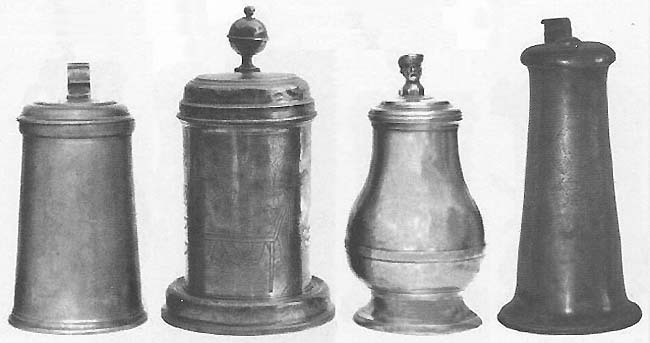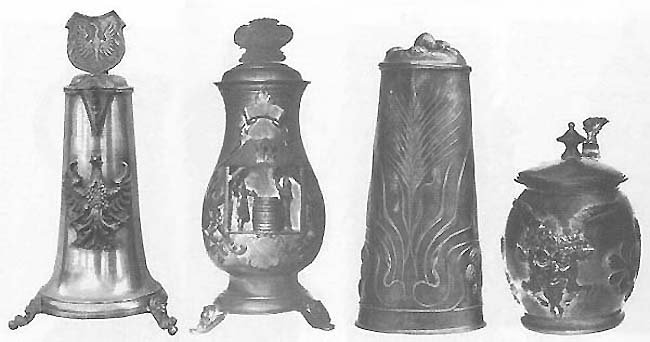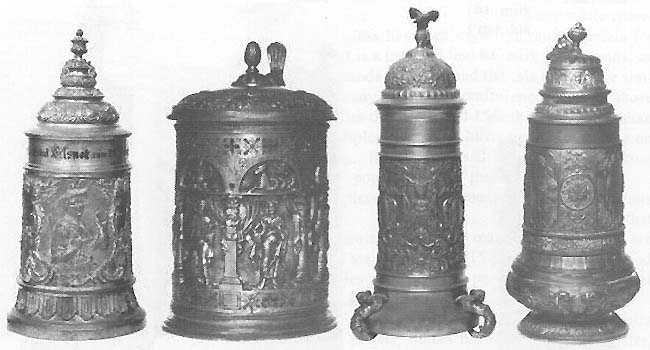 |
| Left to right — Saxony, 1.0L, early 1800s; Saxony, 1.0L, engraved, dated 1820; Saxony, .75L, c. 1800; Breslau, 1.0L, engraved, dated 1677. |
by Gary Kirsner
The History of Pewter Steins
For centuries, pewter was the most popular material used for making eating and drinking utensils. Pewter does not tarnish, rust, or break, and of great importance in the stein business, it does not impart a taste to beer, as do copper, silver, and iron. It was not until the 1700s that stoneware replaced pewter as the material of choice for most steins.
Shaping and decorating pewter is so easy that there have been many very different techniques used in making pewter steins. In the 1500s, pewter steins were either decorated in cast or hammered relief or by engraving or incising. The handles were relatively thin, S-shaped straps of pewter. Motifs commonly contained allegorical scenes within arcades or bands. At that time, the best relief pewter steins were produced in Saxony and Nuremberg. The quality of the engraved decorations on pewter steins made during the 1500s and 1600s usually depended on whether the pewterer did it himself or sent it to a specialist, such as a copperplate engraver.
 |
| Left to right — Saxony, 1.0L, early 1800s; Saxony, 1.0L, engraved, dated 1820; Saxony, .75L, c. 1800; Breslau, 1.0L, engraved, dated 1677. |
Occasionally, gilded pewter steins from the 1600s and 1700s are found. Enameling of pewter steins, however, may have been somewhat more popular, especially in the 1700s and early 1800s when pewter steins were not competing well with the more colorful faience, stoneware, and glass steins.
Around 1800, and especially in the ensuing Biedermeier period, many pewter steins were produced in the Walzenkrug shape: cylindrical and about twice as high as wide. Tiny zigzag, or wrigglework, engraving was quite popular in Germany and Switzerland then, and the designs are in the typical folk art style that was the fashion in that period.
After 1850, during the Historicism period, neo-Renaissance designs abounded on pewter steins: cartouches, masks, fruit bundles, garlands, and other classical devices arranged in panels or covering the stein bodies.
At the beginning of the twentieth century, pewter steins underwent their last important stylistic change to a design that often captures the sinuous lines of the Art Nouveau period.
It is probably true that the outstanding metalworking artists have always preferred silver or gold to pewter. However, pewter steins by Günther, Wiegold, Wildt, and other top artists from the 1600s are as eagerly sought as any metal tankards.
 |
| Left to right — Relief, 1.5L late 1800s; Relief; 1.5L, occupational (barrel maker), late 1800s; Relief, 2.0L, marked Osiris, Art Nouveau style, c. 1900; Relief, .5L, devil, Art Nouveau style, late 1800s. |
Regional differences in shape can help identify the locality in which a pewter stein was made. Rorken, or footed vase shapes, are more commonly from North Germany. Pear-shaped pewter steins are often from Schlesien, Bohemia, Hungary, or southern Germany. Also from southern Germany, as well as Austria and Switzerland, are the tall, tapered pewter steins.
Production and Marks
Due to the scarcity and high cost of pewter in early times, designs were often hammered into molds to save material that would be lost in casting. Lids, handles, and thumblifts also were often made in separate pieces and soldered together. Early molds were usually made from mixtures of calves’ hair and clay, except for complicated molds, which were often made of stoneware. Metal molds began to be used for complicated relief pieces in the late 1500s. These molds slowly gained popularity among craftsmen until, by the 1800s, pewter steins were often made from iron molds.
Touchmarks can frequently be used to identify the origin of pewter steins made between 1600 and 1800. Not only is the master pewterer’s touchmark often visible, but the town’s touchmark is commonly seen on steins, especially on those from the middle 1700s. Although touchmarks are known to have been used in the 1500s, few very early steins are marked.
During the 1800s, pewterers began stamping steins with their full names, and often their city’s name as well, thus removing much of the mystery from touchmark identification.
Pewter comes in three basic types, depending on the recipe. The best genuine (Lautere) pewter has a light color and is made from lead-free tin with small additions of copper, antimony, or bismuth. Probezinn, or proved pewter, occasionally called Reichsprobe, Probe, or similar names, contains about a ten-to-one ratio of tin to lead. Low (Geringen) pewter has a six-to-one ratio. Beginning in the 1700s, a fourth type of pewter was developed when antimony was added to pewter alloys to make a very different material — Britannia metal.
 |
| Left to right — Relief, .5L, woman sharpshooter, c. 1900; Relief; 1.5L, knights, late 1800s; Relief, 1.0L, mascaroons and cartouches, dated 1898; Relief, 1L, marked F.&M.N., four seasons in panels, late 1800s. |
Steins are often stamped to identify the quality of the pewter. Sometimes KL is used for genuine (k1ar und lauter = clear and pure); X is for Probezinn. Sometimes just the ratio appears, like 10:1. In the 1800s, it was common to see Feinzinn or Englishzinn, for lead-free pewter. In the 1700s, the absence of lead was often indicated by a touchmark that showed an angel with either a sword and balance or a palm frond and trumpet.
One final mark of importance is KAYSERZINN, or KZ. This is an antimony-pewter alloy used by the Kayser factory from the late 1800s to the early 1900s.
Collecting Pewter
During the Historicism period, many early styles were reproduced. These were not originally intended as fakes, but removal of the manufacturer’s name at a later time has occasionally misled buyers. Most of these reproductions are cast, often in sand or gypsum/plaster molds, which are not as sharp as originals. Knowledge of marks and purity and the study of originals will greatly help the beginning collector to identify these reproductions.
Pewter can get sick, either with a black flaking disease or a powdering disease. In either case, the pewter may be slowly eaten away until there are actually holes in it. Leaving steins wrapped in accidentally dampened newspapers (which contain sulfur) will greatly accelerate the damage done by these diseases. Polishing (and darkening, if desired) is virtually the only way to arrest these diseases, which can, incidentally, spread to neighboring pieces.
__________
*Reprinted by permission from The Beer Stein Book: a 400 Year History, 3rd edition, 1999, Glentiques, Ltd., Coral Springs, FL.